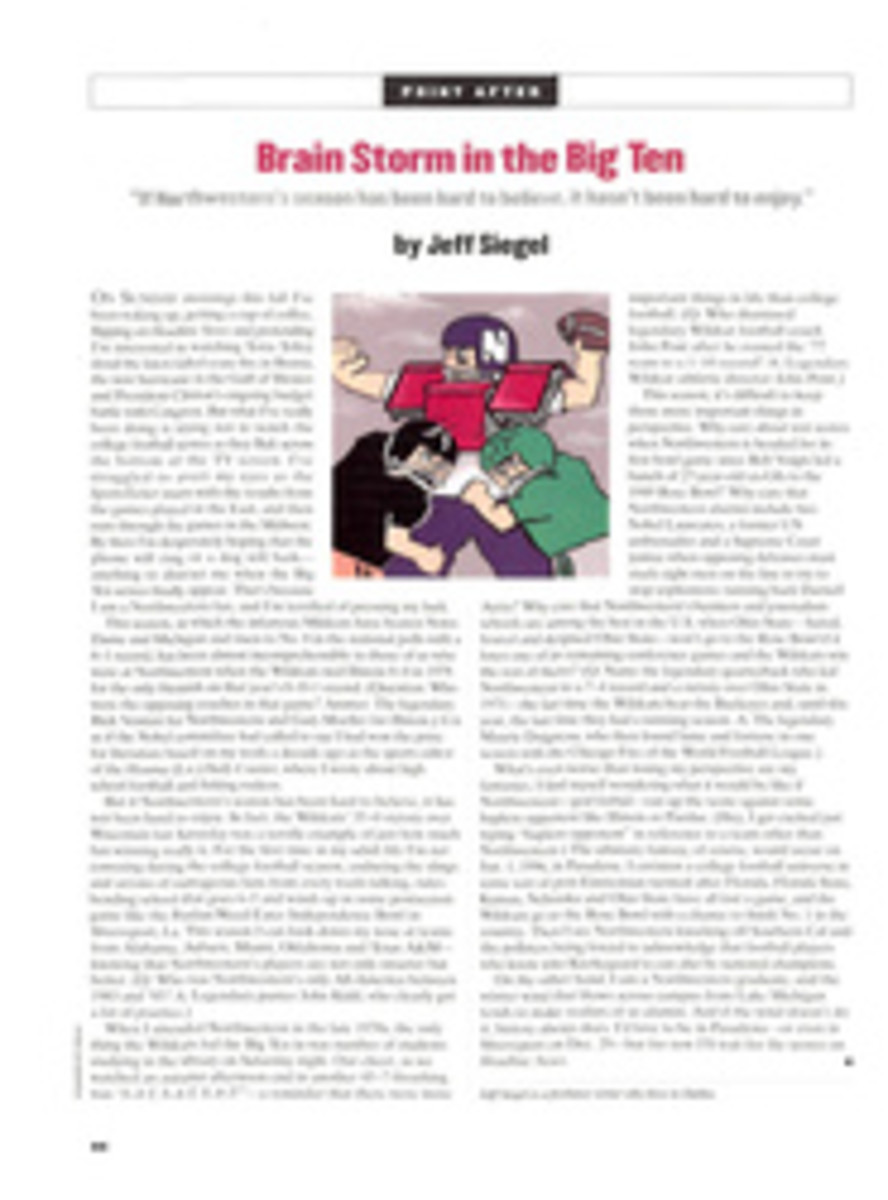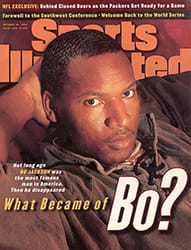
NONE WHO HAVE PLAYED IT ARE WELL AT VENERABLE ETON, BOYS ARE TOUGHENED BY THE BRUTAL, INCOMPREHENSIBLE WALL GAME
Alas, regardless of their doom,
The little victims play.
--Thomas Gray
Ode on a Distant Prospect of Eton College
The students look like penguins, the teachers are known as
beaks, and both pupils and pedagogues wear "tails." So much for
the school's claims to humanity. Having tea is "messing,"
monitors are called "praepostors," and terms are known as
halves, making for three halves in every year. So much for
reason. And, whenever a student passes a teacher in the street,
each party must acknowledge the other by solemnly, silently
raising his right index finger in greeting (thus causing a
teacher who passes a gaggle of charges to flick his finger up
and down like a woodpecker on speed). So much for ceremony.
But it is only on the playing fields of Eton that all the insane
impulses of England's premier, 555-year-old high school--now
being attended by Prince William, heir to the British
throne--really come to the fore.
The Battle of Waterloo may have been won on that hallowed turf,
but minds, limbs and nerves are lost there every year. For Eton
fields a riot of homegrown sports played nowhere else in the
world yet celebrated everywhere for their mad brutality. Of all
these curious traditions, the most peculiar and the oldest is
the Wall Game. Few who have seen it are alive, and none who have
played it are well. During my five years at Eton, I built a
career at the Wall that was glorious though, in its way,
typical: I never scored a goal; I never saw a goal scored; and
in terrible fact, I never set eyes, let alone feet, on the ball.
For all that, the Wall Game has a breathtaking simplicity. A
soiled and soggy ball is placed along the eponymous Wall, a
278-year-old structure 11 feet high and roughly 355 feet long. A
small boy sits, henlike, on top of the soccer-style ball. About
15 of the game's other 19 players--called seconds, walls and
longs--pile on top of the small boy, forming a rugbylike scrum
known with killing aptness as the bully (rugby, you may recall,
was devised at another of England's high schools). Then, after a
signal from the umpire (usually a teacher in mufti), the boys
push, shove and tackle one another, while the bully shakes
around in a many-legged frenzy that, as one appreciative former
housemaster put it, resembles the "death throes of some
monstrous crab." After 30 minutes of this fun the players change
ends and blearily set about knocking heads for another 30
minutes. The Wall Game, they say, is an acquired taste.
Yet there is to the madness a demented method. At the northern
end of the playing area (a strip of grass 15 feet wide running
along the redbrick Wall) a tiny black door that opens onto a
private garden serves as a goal; its counterpart at the southern
end is the trunk of an ancient elm. In between pummeling
princelings and potentates, the players in the bully try to move
toward the goal by clutching the ball between their ankles and
hopping through the mess of enemy forces, all the while keeping
the ball in contact with the Wall. This is not much harder than
balancing an egg on one's nose while crawling through the
trenches of Verdun. Far behind the bully, the other two players
on each team stand around idly, painting their fingernails. One
is called a flying man or fly. Both, however, might easily be
mistaken for spectators. If the ball makes one of its biennial
appearances outside the bully, the job of these "behinds" is to
lumber up to it and kick it toward the opponents' goal. This
happens with the frequency of lunar eclipses.
Scoring is therefore virtually impossible. But the beauty of the
Wall Game is that it makes a mockery of the very notions of
victory and defeat. Since kicking an unseen ball into a tiny
target from 178 feet away is beyond the reach of all mankind,
some allowances are made. If one player close to the opposing
goal lifts the ball up the Wall with his feet (as if juggling a
soccer ball) and a colleague touches it while crying, "Got it!"
their team is allowed to pick up the ball and fling it goalward.
But should that throw be touched by any of the 10 players
defending the unreachable target, it does not count as a
goal--even if by some miracle it hits the target. Scoring by
this method is, therefore, also impossible. In desperation some
benign lunatics declared that the very attempt to make a "shy at
goal" would count for a point. Spurred by this, perhaps, the
Wall Game recently witnessed an offensive explosion: two goals
in the space of 27 years. And Americans think soccer is a snooze!
The Wall Game is, however, anything but stagnant. Heads swathed
in woolen helmets with earflaps, bodies covered in long trousers
and sweaters known fittingly as sacks, hands marginally
protected by gloves, the players struggle as if their lives
depended on it (as perhaps they do). As a description of the
game in the Museum of Eton delicately states (under the heading
of "Violence"), "A player in real danger of fracture or
suffocation may call 'Air,' and play stops while aid is
administered." Yet only the keenest of eyes can distinguish fair
play from foul. Players are, for example, strongly urged to
"knuckle"--to apply "steady pressure" with their fists upon
their opponents' faces. But the rules discourage gouging an
opponent's eye.
Happily, the entire Wall Game season lasts no more than an hour
or a suffocation, whichever comes first. Each year there is only
one official match, pitting 10 unlikely eggheads from the
school's special house for 70 King's Scholars (who practice the
game throughout their careers) against a relatively untrained
but eager squad selected from the 1,130 boys of the other 24
houses (including the likes of Prince William). This contest to
end all contests is played out in the dreary, drizzly fag end of
November, on the traditional school holiday of St. Andrew's Day,
when the grass has turned to mud, and sludge and dark are
epidemic. The last goal scored on St. Andrew's Day came in 1909.
As a spectator sport the Wall Game ranks somewhere between
tortoise-racing and grass-growing. Even "the most exquisite part
of the game," concedes A. Clutton-Brock, chronicler of Eton, "is
a wearisome spectacle for the ignorant onlooker." The Wall Game
is hailed in the Encyclopaedia of Sports and Games as an
inspiration for "aspects of rugby according to the American
code" (none other than American football). But cheerleaders,
Nielsen ratings and splashy visuals are not among those aspects.
It is fair, in fact, to say that the only pleasures to be had
from watching the Wall Game are purely malevolent. Thus, one
Humpty-Dumptian convention allows younger boys to perch atop the
Wall and, for a few giddy moments, look down (in every sense) on
the bigger brutes who usually beat and bully them. Others find a
rare delight in watching future prime ministers wallow in the
mud while likely poets laureate gasp desperately for air. During
one improvised contest, his zealous comrades used Percy Bysshe
Shelley as a goal; more recently, George Orwell distinguished
himself with play described in the official Wall Game report as
"conspicuously bad."
Both of those underachieving wallflowers, however, went on to
become hardy perennials. For if the Wall Game tries men's souls,
it also toughens their fiber. Cynics would say this is no
different from the proverbial act of the numskull who bangs his
head repeatedly against a wall so that he can exult when the
torture is over. But the Wall Game is much more than a thinking
man's form of self-abuse: It is, in effect, a crash course in
the art of becoming a noble savage in reverse. The game builds
builders of empires, instills stoicism and strength and teaches
Darwinian truths about the survival of the fittest. According to
Clutton-Brock, "The enduring wall [a player in the bully] tastes
something of the triumph of Ajax at the ships." It hardly
matters that he strikes the spectator as "merely a blind
obstruction or nuisance."
Throughout the time I was at Eton, from 1970 to '74, others of
the school's "sports"--the steeplechase (a five-mile race capped
by a 15-foot water jump), fives (a form of handball for the
homicidal) and the Field Game (another Eton-only confection
combining the most murderous elements of soccer and rugby)--
stretched and strengthened and exercised me. I was driven to
teach English as a second language in order to avoid the Field
Game. I fabricated a sudden and undying passion for chess so as
to steal away from the fives court. I quoted effusively from
Gandhi when conscientiously objecting to running. But as one of
the luckless King's Scholars, I had, I knew, no way of getting
out of the Wall Game. The best tactic, and the real skill of the
game, I decided, would lie in playing it badly. So even as my
classmates were fecklessly knuckling under or kicking themselves
in the shins, I simply performed with such cool incompetence in
practice matches that I was sure never to be asked to play in
the real thing.
Yet to this day I cannot count myself safe. There is, after all,
only one Wall Game, and only one Wall, on the planet; there are
fewer than 1,000 lucky souls still alive who can claim to have
knuckled a behind, or distinguished between "furking" (letting
the ball illegally escape from the bully) and smirking. Since no
other school produces players, every practice game before St.
Andrew's Day requires a "scratch" team of 11 able-bodied--or at
least uncrippled--Old Etonians. And healthy veterans of the Wall
Game are an endangered species. So, more than 20 years after
last watching a second fall, I lie awake at night, terrified
that the phone will ring and summon me to serve King and country
at the Wall. And as a well-trained product of this training in
masochism, I know that it wouldn't be cricket to refuse.
Time Magazine essayist Pico Iyer's most recent book, "Cuba and
the Night," was published this year.
COLOR PHOTO: ANTON WANT/ALLSPORT On St. Andrew's Day, younger boys perch on the wall and giddily watch their elders be pummeled.
COLOR PHOTO: ADRIAN MURRELL/ALLSPORTOnly the keenest of eyes can spot the ball in the bully, where players are strongly urged to "knuckle" their opponents' faces.
COLOR PHOTO: GRAY MORTIMORE/ALLSPORT[See caption above] [Gloved fists punching a boy's face]

